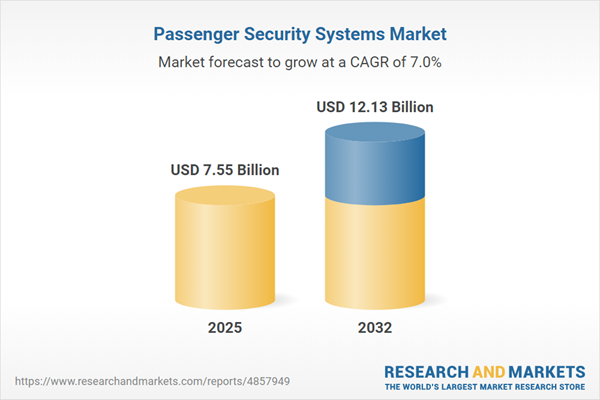Speak directly to the analyst to clarify any post sales queries you may have.
Passenger security systems play a critical role in maintaining safety, regulatory compliance, and operational efficiency across global transportation networks. As evolving threats and higher passenger volumes reshape market demands, organizations are increasingly turning to advanced solutions for reliable security screening and improved traveler experience.
Market Snapshot: Passenger Security Systems Market Growth
The Passenger Security Systems Market grew from USD 7.06 billion in 2024 to USD 7.55 billion in 2025. It is expected to continue growing at a CAGR of 6.99%, reaching USD 12.13 billion by 2032. Strong demand is driven by advanced detection technology adoption, data-driven analytics, and regulatory mandates requiring rigorous security protocols. Market expansion is supported by investments in AI, biometric authentication, and modular screening platforms, with growth varying across regions according to infrastructure maturity and local priorities.
Scope & Segmentation of the Passenger Security Systems Market
This report delivers in-depth analysis and forward-looking insights across the following market segments and regions:
- System Types: Biometric security solutions (facial recognition, fingerprint scanners, iris authentication), explosive trace detection (fixed and portable), metal detectors (hand-held, walk-through), millimeter wave scanners (automated, standalone), X-ray inspection systems (computed tomography, projection).
- Technology Categories: AI analytics (behavioral, facial), biometric modalities (facial, fingerprint, iris), imaging technologies (projection, tomography), sensor technologies (chemical, radiation detection).
- End Users: Critical infrastructure (power plants, telecom, water treatment), government facilities (border security, military installations, prisons), public venues (event centers, shopping malls, stadiums), and transportation hubs (air, rail, sea terminals).
- Distribution Channels: Direct sales, distributors, online channels.
- Service Types: Installation and maintenance (corrective, preventive), managed services (on-site support, remote monitoring), and training and consultancy (operator training, security audits).
- Geographical Coverage: Americas (North America, Latin America), Europe, Middle East, Africa, Asia-Pacific; regional markets such as United States, Brazil, United Kingdom, United Arab Emirates, China, India, and others.
- Leading Companies: Smiths Group plc, Nuctech Company Limited, OSI Systems, Leidos Holdings, Analogic Corporation, Astrophysics Inc., CEIA S.p.A, QinetiQ Group, S2 Global Limited, and VOTI Detection Corp.
Key Takeaways for Senior Decision-Makers
- Advanced passenger security systems rely on integrated biometric authentication, AI-driven analytics, and next-generation imaging to improve detection accuracy and operational throughput.
- The convergence of multiple security technologies into unified platforms is streamlining workflows and reducing false positives, enhancing passenger satisfaction and resource allocation.
- Regional market strategies diverge according to regulatory frameworks, infrastructure investment levels, and passenger volume pressures, requiring tailored approaches for each geography.
- Rising adoption of managed services and remote monitoring models enables cost optimization and aligns vendor incentives with system uptime and performance objectives.
- Collaborative initiatives between solution providers, authorities, and service firms support harmonized standards and accelerate the approval process for innovative technologies.
Impact of 2025 United States Tariffs
- New tariffs on imported passenger security equipment have altered global supply chains, prompting manufacturers to localize production and seek tariff-exempt jurisdictions.
- Procurement teams are revising sourcing strategies and incorporating tariff considerations into lifecycle cost analyses to ensure budget resilience and supply continuity.
- Increased costs are encouraging a shift toward modular system components and managed service agreements, enabling organizations to spread expenses over contract periods.
- Industry advocacy groups are seeking harmonized tariff codes and potential relief measures for essential passenger security technologies.
Methodology & Data Sources
This study employs rigorous primary research through structured interviews with sector leaders and regulatory officials, complemented by secondary research from public documents, patent filings, and industry guidelines. Market analysis utilizes frameworks such as SWOT and PESTLE, and all findings are validated by advisory panels to ensure data reliability and relevance.
The Evolving Passenger Security Systems Market: Why This Report Matters
- Gain clear insight into the latest market drivers, technology trends, and regional growth patterns for informed capital allocation and strategic planning.
- Identify emerging procurement models and innovation opportunities across critical infrastructure, public venues, and transportation hubs.
- Benchmark organizational strategies against leading industry players and pinpoint best practices for maintaining operational resilience and compliance.
Conclusion
Continuous innovation, strategic supply chain management, and tailored regional approaches are essential for success in the evolving passenger security systems market. Accessing reliable intelligence empowers organizations to enhance security, streamline workflows, and uphold compliance in a dynamic threat environment.
Additional Product Information:
- Purchase of this report includes 1 year online access with quarterly updates.
- This report can be updated on request. Please contact our Customer Experience team using the Ask a Question widget on our website.
Table of Contents
3. Executive Summary
4. Market Overview
7. Cumulative Impact of Artificial Intelligence 2025
Companies Mentioned
The companies profiled in this Passenger Security Systems market report include:- Smiths Group plc
- Nuctech Company Limited
- OSI Systems, Inc.
- Leidos Holdings, Inc.
- Analogic Corporation
- Astrophysics Inc.
- CEIA S.p.A
- QinetiQ Group plc
- S2 Global Limited
- VOTI Detection Corp.
Table Information
| Report Attribute | Details |
|---|---|
| No. of Pages | 188 |
| Published | October 2025 |
| Forecast Period | 2025 - 2032 |
| Estimated Market Value ( USD | $ 7.55 Billion |
| Forecasted Market Value ( USD | $ 12.13 Billion |
| Compound Annual Growth Rate | 6.9% |
| Regions Covered | Global |
| No. of Companies Mentioned | 11 |









